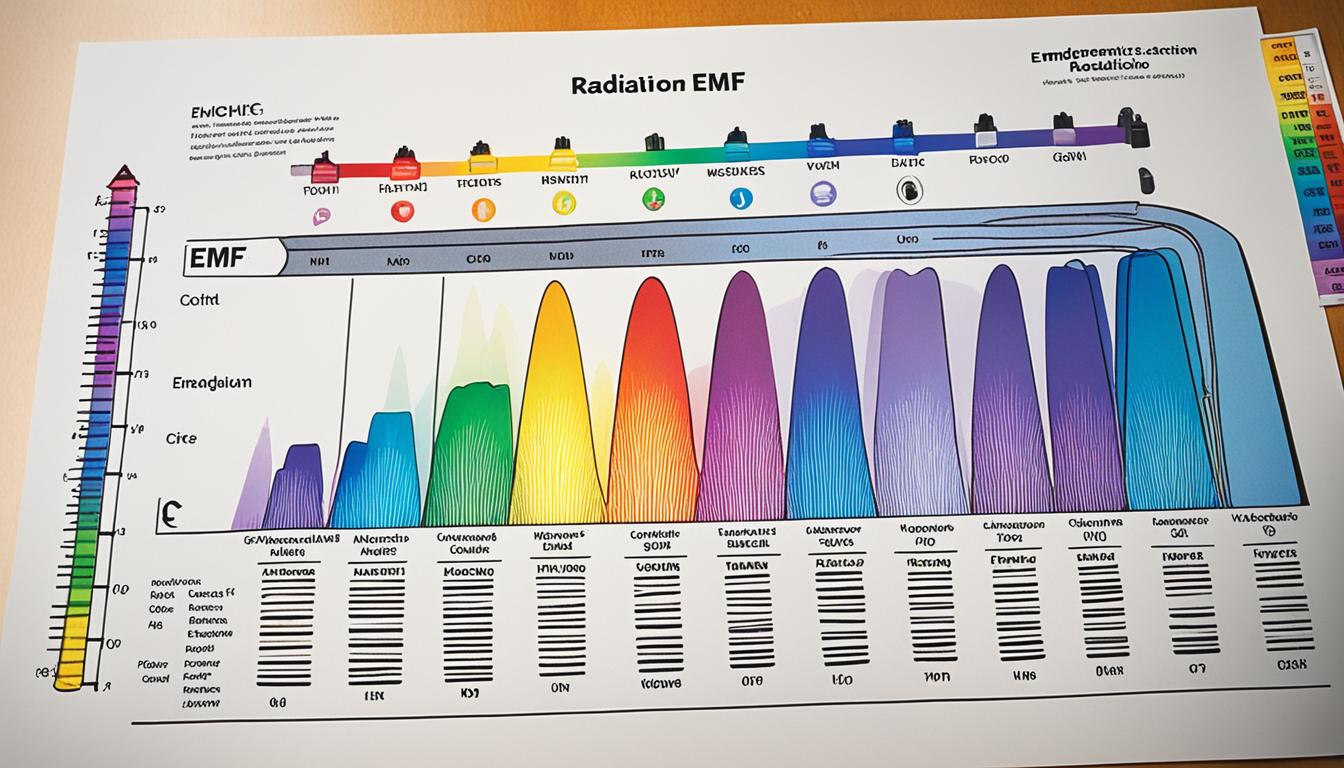Disclosure: This Post Contains Affiliate Links; We earn a commission on purchases.
Electromagnetic fields (EMFs) are an integral part of our modern world. They are generated by various sources, including power lines, electrical devices, cell phones, and Wi-Fi networks. While EMFs are essential for many technologies we rely on, there are concerns about their potential health effects.
EMFs can be categorized into two types: non-ionizing and ionizing radiation. Non-ionizing radiation includes low to mid-frequency EMFs, such as radio frequency (RF), electric fields, and magnetic fields. These types of EMFs are generally perceived as harmless and are emitted by everyday devices like cell phones and electrical appliances.
On the other hand, ionizing radiation consists of high-frequency EMFs, such as ultraviolet (UV), X-rays, and gamma rays. These types of EMFs can potentially cause cellular and DNA damage with prolonged exposure. However, it is important to note that the levels of ionizing radiation we encounter in our daily lives are typically much lower than those used in medical imaging or radiation therapy.
While some studies have shown a possible link between EMF field strength and an increased risk for childhood leukemia, there is no evidence of a link between EMF exposure and adult cancers. However, concerns persist about the possible health effects of EMFs from modern technologies like cellular telephones and wireless routers.
Key Takeaways:
- EMFs are generated by various sources in our daily lives, including power lines, cell phones, and Wi-Fi networks.
- Non-ionizing radiation, such as RF, electric fields, and magnetic fields, is generally perceived as harmless.
- Ionizing radiation, including UV, X-rays, and gamma rays, can potentially cause cellular and DNA damage.
- Concerns about the health effects of EMFs exist, but evidence of a direct link to adverse health effects in adults is limited.
- Further research is needed to fully understand the potential risks of EMF exposure.
Non-Ionizing Radiation: ELF, RF, and Microwaves
Non-ionizing radiation encompasses various forms of electromagnetic fields (EMFs) that are considered to be of lower energy compared to ionizing radiation. This includes extremely low frequency (ELF), radio frequency (RF), and microwaves. While these types of EMFs are generally regarded as harmless to humans, concerns persist regarding their potential long-term effects on health.
Extremely Low Frequency (ELF)
ELF radiation is commonly emitted by power lines and electrical devices that we encounter in our daily lives. Although the energy levels of ELF radiation are relatively low, studies have suggested a possible association between chronic exposure to high levels of ELF radiation and health issues.
Radio Frequency (RF)
RF radiation is emitted by various sources, including cell phones, Wi-Fi networks, smart meters, and other wireless devices. With the increasing prevalence of these technologies in our modern world, concerns have been raised about potential health effects associated with prolonged RF radiation exposure.
Microwaves
Microwaves, as the name suggests, are emitted by microwave ovens and radar equipment. While microwaves are primarily used for cooking and communication purposes, questions remain regarding their long-term impact on human health.
While non-ionizing radiation is generally considered to be less harmful, it is important to be cautious and stay informed about potential risks associated with prolonged exposure to ELF, RF, and microwaves. Ongoing research is necessary to further understand the long-term effects of these types of EMFs on human health.
Ionizing Radiation: UV, X-Rays, and Gamma Rays
Ionizing radiation poses a greater risk compared to non-ionizing radiation. It includes UV, X-rays, and gamma rays, which have the potential to cause cellular and DNA damage with prolonged exposure.
UV radiation is emitted by the sun and tanning beds, making it an unavoidable environmental factor. It is important to protect ourselves from excessive UV exposure by using sunscreen, wearing protective clothing, and seeking shade when the sun’s rays are strongest.
| Type of Ionizing Radiation | Source | Applications |
|---|---|---|
| UV radiation | The sun, tanning beds | Skin tanning, vitamin D synthesis |
| X-rays | Medical imaging equipment | Diagnosing fractures, tumors, dental issues |
| Gamma rays | Radiation therapy machines | Cancer treatment |
X-rays and gamma rays are widely used in medical imaging and radiation therapy. X-rays help diagnose fractures, tumors, and dental issues, while gamma rays are used in cancer treatment. While these technologies offer valuable medical insights and interventions, precautions are taken to minimize exposure to ionizing radiation.
Minimizing Exposure and Ensuring Safety
- Medical professionals follow strict guidelines to limit exposure during X-ray procedures and radiation therapy. Lead aprons and shields are used to protect other parts of the body from unnecessary exposure.
- Patients undergoing medical imaging or radiation therapy are closely monitored to ensure the dosage is as low as reasonably achievable (ALARA).
- Public safety measures, such as restricting access to radiation sources and monitoring exposure levels in medical facilities, are in place.
EMF and Health Effects
As the research on electromagnetic fields (EMFs) and their impact on health continues, the current evidence suggests a limited direct link between EMF exposure and adverse effects in adults. However, there are certain health concerns associated with EMFs that warrant attention.
Studies have revealed a possible connection between EMF field strength and an increased risk of childhood leukemia. While the overall association remains weak and further research is needed to fully comprehend the potential risks, it is crucial to exercise caution and limit exposure to EMFs, especially in vulnerable populations such as children.

“Although the direct impact of EMFs on adult health is inconclusive, it is important to adopt preventive measures to minimize potential risks.”
To address these concerns, individuals can take proactive steps to reduce their exposure to EMFs. This can include using wired connections instead of wireless networks, employing shielded data cables, and turning off Wi-Fi signals when not in use.
While the research on EMFs and their health effects is ongoing, it is prudent to remain informed and exercise caution. By staying updated on the latest studies and implementing appropriate measures to limit exposure, individuals can prioritize their well-being in an increasingly interconnected world.
EMF Sources in Daily Life
Electromagnetic fields (EMFs) are present in various sources that we encounter in our daily lives. It is essential to be aware of these sources and take necessary precautions to limit our exposure to EMFs.
Non-Ionizing EMF Sources
Non-ionizing EMF sources include:
- Power lines: These are a common source of EMFs, as they carry electricity to our homes and businesses.
- Electrical devices: Electronics such as computers, televisions, and kitchen appliances emit EMFs.
- Cell phones: Mobile phones emit RF radiation, which is a type of non-ionizing EMF.
- Wi-Fi networks: Wireless internet connections emit RF radiation as well.
- Microwave ovens: These appliances generate EMFs when in use.
Ionizing EMF Sources
Ionizing EMF sources include:
- The sun: UV radiation emitted by the sun is a form of ionizing EMF. It is important to protect ourselves from excessive sun exposure.
- Medical imaging equipment: X-rays and gamma rays used in diagnostic imaging and radiation therapy emit ionizing EMFs.
- Radiation therapy machines: These medical devices use ionizing EMFs to treat certain conditions.
By being aware of these EMF sources, we can make informed decisions and take appropriate steps to reduce our exposure. Whether it’s limiting the use of electrical devices, practicing safe sun habits, or using protective measures in medical settings, being proactive about EMF sources is an important aspect of maintaining a healthy lifestyle.
“Being aware of the various sources of EMFs in our daily lives allows us to make conscious choices that prioritize our well-being.” – Dr. Emily Roberts, EMF Specialist
Limiting and Shielding EMFs
When it comes to EMF protection and reducing EMF exposure, there are practical steps you can take to safeguard yourself and your family. By limiting your exposure to RF radiation and shielding electric fields, you can minimize the potential risks associated with EMFs.
Limiting RF Radiation
RF radiation is emitted by various wireless devices and networks, including Wi-Fi signals and Bluetooth devices. To reduce your exposure, consider the following:
- Turn off Wi-Fi signals when not in use.
- Use shielded data cables instead of wireless connections whenever possible.
- Minimize the use of wireless Bluetooth devices, opting for wired alternatives whenever feasible.
Shielding Electric Fields
Electric fields can be shielded to provide an added layer of protection. Here are a few methods:
- Shut off power to certain rooms or areas when they are not in use.
- Use shielded wiring to help contain and redirect electric fields.
Reducing Dirty Power
Dirty power refers to electrical disruptions caused by electronic devices. To reduce dirty power and limit your exposure to EMFs, consider the following:
- Use filters to clean up the electrical current in your home or office.
- Avoid certain types of lighting that can introduce electrical disruptions.
By exploring these alternatives and implementing measures to limit and shield against EMFs, you can take proactive steps towards EMF protection and reducing your exposure.

EMF Safety and Guidelines
In order to ensure the safety of individuals, national and international health and scientific agencies have established guidelines and exposure limits for electromagnetic fields (EMFs). These guidelines are the result of extensive research and aim to provide clear recommendations for reducing potential risks associated with EMF exposure.
It is important for individuals to adhere to these guidelines and take appropriate steps to minimize their exposure to EMFs. By implementing the following measures, you can create a safer environment:
Limit Wireless Devices
Reduce your usage of wireless devices such as cell phones, tablets, and wireless headphones. When possible, opt for wired connections to minimize exposure to RF radiation.
Use Wired Connections
Whenever feasible, use wired connections for your electronic devices instead of relying on wireless connections. This helps reduce your exposure to RF radiation emitted by Wi-Fi networks and Bluetooth devices.
Implement Shielding Techniques
Consider implementing shielding techniques to reduce your exposure to EMFs. This can include using shielding materials, such as special paints or fabrics, to block or absorb RF radiation. Properly shielding your living and working spaces can provide an additional layer of protection.
By following these guidelines and adopting these practices, you can take important steps towards ensuring EMF safety for yourself and your family. It is important to stay informed about the latest research and recommendations to make informed decisions regarding EMF exposure.
| EMF Safety Measures | Benefits |
|---|---|
| Limiting wireless device usage | – Reduced exposure to RF radiation – Lower risk of potential health effects |
| Using wired connections | – Minimized exposure to RF radiation – Enhanced data security and stability |
| Implementing shielding techniques | – Decreased exposure to EMFs – Added protection against RF radiation |
Remember, practicing EMF safety and following guidelines can help create a healthier and safer environment for everyone.
Resources for Further Information
If you’re looking for more information on EMFs, there are various resources available to help you stay informed and make informed decisions regarding EMF exposure. These resources include:
- Scientific Studies: Numerous scientific studies have been conducted on EMFs and their potential health effects. These studies provide valuable insights into the topic and can help you understand the latest research findings.
- Health Authorities: Established health authorities like the World Health Organization (WHO) and Health Canada provide official information and guidelines on EMFs. Their websites offer comprehensive resources that cover a wide range of EMF-related topics.
- Independent Research Reports: Independent organizations and research institutions often publish reports and studies on EMFs. These reports are valuable sources of information, as they offer different perspectives and insights.
By referring to these resources, you can access reliable and up-to-date information on EMFs. This will help you make informed decisions about your EMF exposure and take appropriate measures to protect yourself and your loved ones.
Conclusion
In conclusion, understanding the different types of electromagnetic fields (EMFs) is crucial in today’s technology-driven world. EMFs are categorized into non-ionizing and ionizing radiation. Non-ionizing EMFs, such as extremely low frequency (ELF), radio frequency (RF), and microwaves, are generally considered harmless. However, caution should be exercised, especially in prolonged exposure.
On the other hand, ionizing EMFs, including ultraviolet (UV), X-rays, and gamma rays, have the potential for cellular and DNA damage. It is important to be mindful of these types of EMFs and limit exposure to protect our health.
By being aware of the sources of EMFs, implementing protective measures, and following safety guidelines, individuals can minimize their exposure and create a safer environment. It is recommended to refer to reputable resources and research studies to stay informed about the potential risks and make informed decisions regarding EMF exposure.
Source Links
- https://www.niehs.nih.gov/health/topics/agents/emf
- https://passionelectric.com/understanding-emfs/
- https://www.bchydro.com/content/dam/BCHydro/customer-portal/documents/corporate/safety/understanding-emf-booklet.pdf

Subscribe to Our Newsletter










